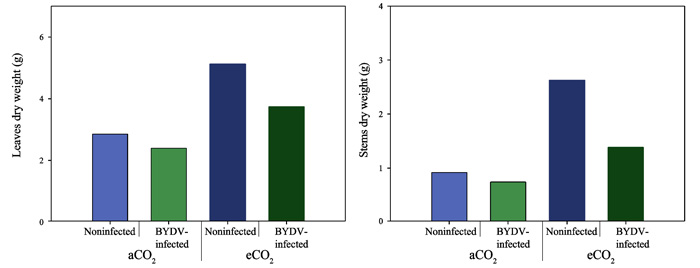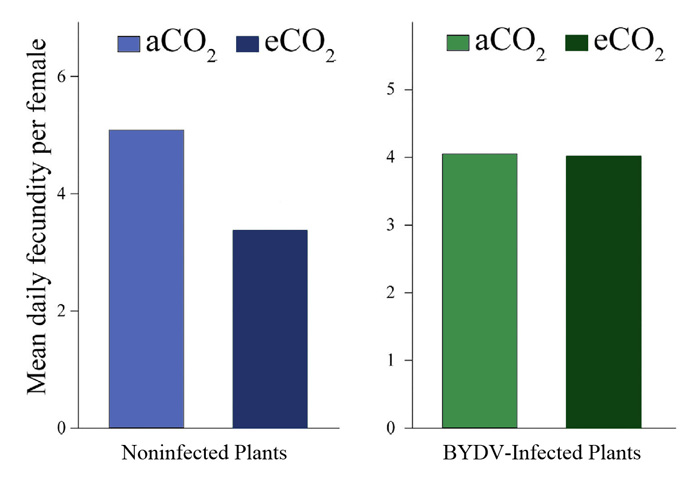| Follow @co2science |
Paper Reviewed
Trébicki, P., Vandegeer, R.K., Bosque-Pérez, N.A., Powell, K.S., Dader, B., Freeman, A.J., Yen, A.L., Fitzgerald, G.J. and Luck, J.E. 2016. Virus infection mediates the effects of elevated CO2 on plants and vectors. Scientific Reports 6: 22785, DOI: 10.1038/srep22785.
Introducing the rationale for their study, Trébicki et al. (2016) write that aphids are "among the most important agricultural pests worldwide and are major vectors of plant viruses; therefore, understanding the impact of elevated CO2 (eCO2) on aphid population dynamics and interactions with pathogens is essential in order to predict epidemiology of plant diseases under future climate."
In a step directed toward accomplishing this goal, the team of nine scientists designed an experiment in which they examined the interaction between aphid (Rhopalosiphum padi) herbivore activity and Barley yellow dwarf virus (BYDV) infection on wheat (Triticum aestivum, c.v. Yitpi), which they grew in controlled environment chambers under ambient (385 ppm) and elevated (650 ppm) CO2 concentrations. And what did their study reveal?
First of all, the authors report that eCO2 "had a positive effect on growth of both noninfected and BYDV-infected plants," and largely so as seen in Figure 1. For example, eCO2 increased the combined leaf and stem dry mass in non-infected wheat plants by a whopping 106 percent! For BYDV-infected plants it increased it by a respectable 63 percent.

Leaf (left panel) and stem (right panel) dry weight of five-week-old non-infected and BYDV-infected wheat plants grown under ambient (aCO2; 385 ppm) or elevated CO2 (eCO2; 650 ppm). Adapted from Trébicki et al. (2016) figure S4.
With respect to aphid development and reproduction, as illustrated in the left panel of Figure 2, the authors report there was a significant reduction in R. padi fecundity in the eCO2 treatment of non-infected wheat, where the average daily production of nymphs per adult was reduced by 33 percent (5.08 nymphs under ambient CO2 conditions vs. 3.37 under eCO2, P<0.001). In addition, they note the average number of aphid nymphs per adult from the time of birth to (1) the onset of reproduction and to (2) the end of the experimental period decreased by 26 percent and 34 percent, respectively. Furthermore, Trébicki et al. determined that "the intrinsic rate of natural increase and mean relative growth rate also significantly decreased under eCO2 by around 10 percent," which cumulative observations led them to ultimately conclude "we expect potentially lower future aphid populations on noninfected plants." In contrast, there was no significant effect of CO2 treatment on aphid fecundity in BYDV-infected wheat (Figure 2, right panel).

Figure 2. Mean daily fecundity per female recorded on non-infected (left panel) and BYDV-infected (right panel) wheat plants grown at ambient (385 ppm) or elevated (650 ppm) CO2 concentrations. Adapted from Trébicki et al. (2016).
Given the findings presented above, it would appear that aphid herbivore activity by R. padi will likely remain at similar or reduced levels on wheat in a CO2-enriched world of the future. And that should bode well for wheat harvests, as Trèbicki et al. identify R. padi as "one of the most economically important insect pests of wheat" and "the main vector of BYDV."
Posted 23 August 2015



